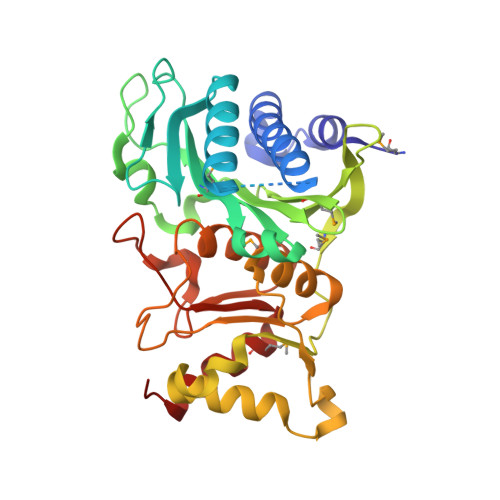Novel Allosteric Activation Site in Escherichia coli Fructose-1,6-bisphosphatase.
Hines, J.K., Fromm, H.J., Honzatko, R.B.(2006) J Biological Chem 281: 18386-18393
- PubMed: 16670087
- DOI: https://doi.org/10.1074/jbc.M602553200
- Primary Citation of Related Structures:
2GQ1 - PubMed Abstract:
Fructose-1,6-bisphosphatase (FBPase) governs a key step in gluconeogenesis, the conversion of fructose 1,6-bisphosphate into fructose 6-phosphate. In mammals, the enzyme is subject to metabolic regulation, but regulatory mechanisms of bacterial FBPases are not well understood. Presented here is the crystal structure (resolution, 1.45A) of recombinant FBPase from Escherichia coli, the first structure of a prokaryotic Type I FBPase. The E. coli enzyme is a homotetramer, but in a quaternary state between the canonical R- and T-states of porcine FBPase. Phe(15) and residues at the C-terminal side of the first alpha-helix (helix H1) occupy the AMP binding pocket. Residues at the N-terminal side of helix H1 hydrogen bond with sulfate ions buried at a subunit interface, which in porcine FBPase undergoes significant conformational change in response to allosteric effectors. Phosphoenolpyruvate and sulfate activate E. coli FBPase by at least 300%. Key residues that bind sulfate anions are conserved among many heterotrophic bacteria, but are absent in FBPases of organisms that employ fructose 2,6-bisphosphate as a regulator. These observations suggest a new mechanism of regulation in the FBPase enzyme family: anionic ligands, most likely phosphoenolpyruvate, bind to allosteric activator sites, which in turn stabilize a tetramer and a polypeptide fold that obstructs AMP binding.
- Department of Biochemistry, Biophysics, and Molecular Biology, Iowa State University, Ames, Iowa 50011, USA.
Organizational Affiliation:


















